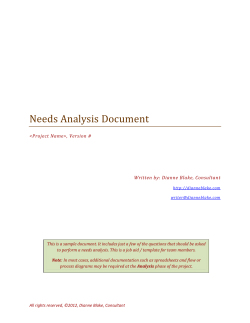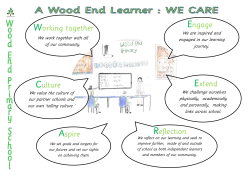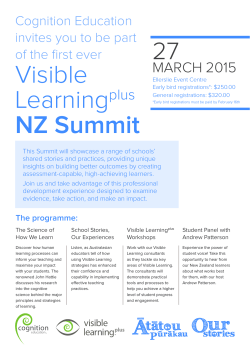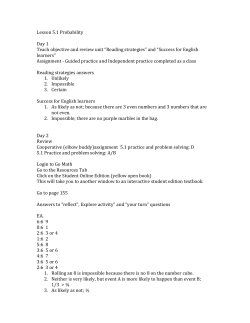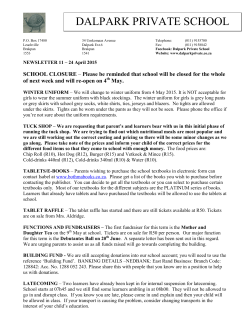
Teaching vocabulary in the primary classroom
Teaching vocabulary in the primary classroom Torill Hestetræet Department of Cultural Studies and Languages, University of Stavanger, Norway Abstract: This article presents findings from a national questionnaire survey on teachers’ beliefs and practices about teaching and learning English vocabulary in the Norwegian primary school classroom. Teachers’ reported vocabulary activities in an open-ended question have been broadly categorised into intentional and incidental ways of teaching vocabulary. Primary categories were based on Nation’s (2001, 2008) four strands for teaching vocabulary: meaning-focused input by means of exposure, meaning-focused output by using the language, language-focused learning by explicit study of vocabulary and fluency development by using familiar vocabulary. Secondary categories were the use of translation, pictures, vocabulary tests and pupils choosing vocabulary. The findings indicate a predominance of language-focused learning and a consequent need to balance intentional vocabulary learning with incidental learning, for example through extensive reading. Introduction and aims Vocabulary constitutes the building blocks of language and is therefore important in second language learning. In recent decades, vocabulary has received increasing attention from researchers (Nation, 2001; Schmitt, 2008; Schmitt & McCarthy, 1997). Because of language corpus research established in the 1980s, much more is now known about L1 and L2 vocabulary. In terms of vocabulary size and high and low frequency words, for example, one now knows how many, and what, word families are needed for a second language (L2) learner to get by or read in English (Schmitt, 2008). It is also recognised that much L1 English vocabulary consists of formulaic language, such as collocations, idioms and fixed phrases (Barcroft, Sunderman & Schmitt, 2011). A lot is also known about the ways in which vocabulary is learnt, although more research is necessary (Schmitt, 2008). In order to widen understanding of vocabulary learning it is important to know about the beliefs and practices of teachers. The field of teacher cognition aims to study “what language teachers think, know and believe and the relationships of these mental constructs to what teachers do in the language classroom in connection with different sub-disciplines within ENGLISH FOR YOUNG LEARNERS – FORUM 2012 • 1 language learning ” (Borg , 2003: 81).There have been studies on teacher cognition and language learning disciplines such as grammar, reading and literacy, as outlined by Borg (2006). However, there is a lack of research about teacher cognition and the teaching and learning of L2 vocabulary. In L1 contexts, Konopak and Williams (1994) have studied elementary teachers’ beliefs about L1 vocabulary learning, while Hendrick, Harmon and Linerode (2004) investigated middle and intermediate school teachers’ beliefs and practices about vocabulary instruction in social studies. This article presents some questionnaire findings about Norwegian 7th grade in-service teachers’ beliefs and practices concerning the teaching and learning of English vocabulary. The aims are to map these beliefs and practices and to categorise what vocabulary activities the teachers report using and those they think work well. The language acquisition of young language learners has received more focus among researchers internationally (Drew & Hasselgreen, 2008), partly because the starting age of foreign or second language learning has been lowered in both Europe and the rest of the world (Rixon, 2000). In Norway, obligatory English is introduced to six-year-olds in the first grade. Vocabulary learning and teaching An important distinction in vocabulary studies is that between incidental and intentional learning (Ellis, 1994; Nation, 2001; Schmitt, 2008). Incidental learning happens subconsciously when the learner is using the language and focusing on content, and it is therefore dependent on meaning-focused exposure, for example through extensive reading and listening. Intentional learning, on the other hand, is conscious and involves the explicit study of words, with attention to form. Both approaches are important for successful vocabulary development. While effectiveness is the main argument in favour of intentional learning, incidental learning is believed to be important for developing both a large vocabulary and useful vocabulary learning strategies, such as guessing meaning from context. A survey conducted among Norwegian primary school teachers by Drew (2004), indicated frequent use of intentional approaches, with translation and vocabulary tests on individual words, along with a strong reliance on the textbook. Incidental approaches, along with supplementary attention to language form, are seen as the currently favoured way of teaching language (Schmitt, 2008:340). Nation (1996, 2008) argues for a balance between approaches. He proposes four strands for teaching vocabulary: meaning-focused input (MI) by means of exposure though listening and reading, meaning-focused output 2 • ENGLISH FOR YOUNG LEARNERS – FORUM 2012 (MO) by using the language productively, language-focused learning (LFL) by explicit study of vocabulary and fluency development (FD) by using familiar vocabulary, collocations and multi-word units and recycling them to encourage storage, retrieval and fluency. The four strands account for both productive and receptive use of the language, and incidental and intentional learning alike, as well as familiar vocabulary and vocabulary at the boundaries of the learners’ knowledge. There should be a balance in the amount of time spent on each of the strands, but they can also be integrated. For example, meaning-focused output can be supplemented with language-focused learning to promote the consolidation of new words (de la Fuente, 2006). Reading promotes language learning and encourages vocabulary building (Elley, 1991; Grabe, 1991; Krashen, 1984, 2004). Extensive reading is understood as reading for real purposes or for pleasure, where the focus is on the content and not the language (Day & Bamford, 1998). It allows for incidental learning and guessing meaning from context, an important language learning strategy. Intensive reading, on the other hand, is interpreted as reading where the focus is on the language. Nation (2004:20) explains intensive reading as involving “the detailed reading of texts with the two goals of understanding the text and learning language features through a deliberate focus on these items”. Exposure may be particularly important for young learners since they are believed to be predisposed for acquiring languages (Lenneberg, 1967). Another argument in favour of exposure and extensive reading is the need to compensate for the gap in vocabulary size between L1 and L2 learners. Whereas native speakers know 4,000–5,000 word families at the age of five and as many as 20,000 as adult educated speakers (Nation & Waring, 1997), foreign learners of English are reported to have vocabulary sizes ranging from 1,200 to 4,000 word families (Laufer, 2000). Both the incidental and the intentional approaches to teaching vocabulary are reflected in the competence objectives after year 7 of the Knowledge Promotion 2006 English curriculum, the national curriculum for Norwegian primary and secondary schools. Incidental learning is manifested in communication objectives about mastering age-appropriate everyday vocabulary and polite expressions, and in cultural objectives about reading a variety of texts of various lengths. The intentional approach is mirrored in the language learning objectives, where the focus is on knowledge about the language and its usage. ENGLISH FOR YOUNG LEARNERS – FORUM 2012 • 3 Methods The present study is based on a national questionnaire survey sent to 7th grade English teachers in all 2487 Norwegian primary (or combined primary and lower secondary) schools. The response rate was 14%, with 341 responses. The questionnaire included one open-ended and 64 closed-ended questions about the teachers’ beliefs and practices connected to vocabulary learning and teaching (Hestetræet, 2012). This article focuses on the open-ended question. The teachers were asked to describe (in around 50 – 100 words) a vocabulary activity that they had used with 7th grade learners and that seemed to work well. A random sample of 70 responses from the total of 341 has been used for the purposes of this article. The responses have been categorised. Categorisation is all about sorting into groups that have features in common. Prototype categorisation, one of the main types of categorisation, has been chosen for this study (Rosch, 1978; Riemer, 2010; Taylor, 2003). Here, membership is a matter of degree, and some members are seen as more representative than others. For example, apple is seen as a more typical member of the category fruit than pineapple. The members of a category share varied features, but it is not necessary for all the members to share all of these, as is the case in classical categorisation. The notion of similarity to the prototypical member underlies the prototype categorisation process, and is problematic both because it is a subjective notion and because it is difficult to decide how dissimilar two items have to be in order to be allocated to different categories (Taylor, 2003:65). Nation’s (1996, 2008) four strands for teaching vocabulary were used as the basis for the primary categorisation of the responses. They were chosen because they provide a balanced way of teaching vocabulary. However, because there were no examples of fluency activities, this category was unrepresented in the findings. Moreover, in order to make a more fine-tuned continuum of categories, the strands were combined to make the following additional sub-categories: LFL/MI, LFL/MI, LFL/MO/MI and MO/MI. In addition to the above primary categories, some secondary categories that seemed to be prevalent in the material were added to better reflect the scope of the responses: translation from L1 to L2 or vice versa, having vocabulary tests, using pictures as support, the pupils choosing what vocabulary to study in detail, and two or more activities provided in the responses. 4 • ENGLISH FOR YOUNG LEARNERS – FORUM 2012 Findings Table 1 presents an overview of the primary categorisation of the examples of vocabulary activities, from the teachers’ responses to the open-ended question. Category Score (N = 70) Language-focused learning (LFL) Language-focused learning and meaning-focused output (LFL/MO) Meaning-focused output (MO) Language-focused learning and meaning-focused input (LFL/MI) Language-focused learning and meaning-focused input and output (LFL/MO/MI) Other Meaning-focused input and output (MO/MI) Meaning-focused input (MI) 25 (35.7%) 14 (20%) 10 (14.3%) 8 (11.4%) 7 (10%) 4 (5.7%) 2 (2.9%) 0 Table 1: The distribution of primary categorisation of vocabulary activities The two highest scoring categories were LFL with 35.7% and LFL/MO with 20%. The lowest scoring categories were MI, with no instances as a single category, and MO/MI with 2,9%. Interestingly, LFL features in as many as 77% of the examples, MO in 47 %, and MI in 24.3% of the examples. Examples of LFL only activities included memorising words, learning the grammar of words, having vocabulary tests, and translating words. Activities in which LFL was combined with the other primary categories were, for example, vocabulary games (LFL/MO) and reading textbook texts (LFL/MI). The ‘other’ category (5.7%) includes examples that were impossible to categorise, either because they were unclear or because there was too little information. ENGLISH FOR YOUNG LEARNERS – FORUM 2012 • 5 Table 2 indicates the distribution of secondary categorisation of the teachers’ reported vocabulary activities. Category Score (N = 70) Translation Pictures Pupils choose vocabulary Vocabulary test Two or more activities 11 (15.7%) 10 (14.3%) 10 (14.3%) 8 (11.4%) 25 (35.7%) Table 2: The distribution of secondary categorisation of vocabulary activities Activities which included translation, pictures, pupils choosing vocabulary, and having vocabulary tests ranged from 11.4% to 15.7%. Describing two or more activities scored at 35.7%. The following are examples of the teachers’ responses: Example 1: LFL + translation + pupils choosing vocabulary I use bingo lotto. They pick 9 words out of 15 words, and put them in a sheet. If they get bingo, they have to translate the words correctly before they get their name on the scoring list. In this example, bingo lotto is used, a game in which the pupils identify and translate words they have chosen themselves. This activity is languagefocused since it draws attention to learning spelling, pronunciation and translation. Example 2: LFL/MO + picture I make a drawing on the blackboard, and let the learners work in pairs. One of them sits with their back to the blackboard, the other is supposed to describe the drawing so the partner is able to draw it. I also write words from their homework and let them do the same. This is an information gap activity in which one learner instructs another to make a picture or drawing, communicating meaningfully while doing so. The teacher also lets the pupils write words from their homework. Thus it is an example of meaning-focused spoken output, combined with languagefocused learning. 6 • ENGLISH FOR YOUNG LEARNERS – FORUM 2012 Example 3: MO I have found project-based learning a valuable method to teach students new vocabulary. For example, students must make a radio programme on a topic of mutual interest. New topic-related vocabulary is introduced and students must actively use these new words in context. This is a meaning-focused output activity in which the pupils communicate for real purposes though speaking, making a radio programme, using new, topic-related vocabulary in a context. They are encouraged to use these new words at the boundaries of their knowledge. Discussion This article has aimed to map teacher cognition about YLL vocabulary teaching and learning, through categorising vocabulary activities that the teachers reported they used and considered worked well. Language-focused learning was by far the highest-scoring primary vocabulary category, both on its own and in combination with the other primary activities. The focus on intentional vocabulary learning suggests an imbalance between the different primary vocabulary categories, particularly at the expense of meaning-focused input, which had no instances as an independent primary category and only featured in combinations in a quarter of the examples. Firstly, this indicates that meaning-focused input may not be an established notion of what the teachers consider a vocabulary activity to be. Secondly, it implies that the use of activities that support meaning-focused input, and thus incidental learning, such as heavy exposure through extensive reading and listening, should be encouraged in order to sustain successful vocabulary development, with a balance between intentional and incidental learning (Nation, 2008). Thirdly, plentiful meaning-focused input is believed to be necessary for the development of learners’ output, meaning their spoken and written language (Krashen, 1984). In the categorisation process of the questionnaire responses, several challenges were encountered. Firstly, the wording of the open-ended questionnaire item may have influenced the respondents’ answer, although the concept “vocabulary activity” was intended to be as neutral as possible. Traditionally, much attention is given to the intentional teaching approach in Norwegian schools, by memorising words and having vocabulary tests, using a textbook and the activities in it (Drew, 2004; Hestetræet, 2012). It may therefore be the case that the wording “vocabulary activity” invited a response with explicit vocabulary activities, not implicit ones, and may thus have caused an overrepresentation of LFL responses. ENGLISH FOR YOUNG LEARNERS – FORUM 2012 • 7 A further challenge was categorising examples of reading in the material. There was little teaching and learning context in the teachers’ responses, and it was therefore difficult to distinguish between intensive and extensive reading. According to Nation (2008), intensive reading is an example of LFL, but he also claims that reading for study purposes is MI. I have therefore interpreted intensive reading as both LFL and MI, having features from both categories. Extensive reading is clearly an example of MI. Yet another difficulty in categorising was the problem of prior identification (Rosch, 1978). In the case of ‘gloseprøve’, meaning vocabulary test, it was unclear whether the teachers’ responses intended to include Norwegian-English/English-Norwegian translation, or words used in a context, monolingually. The decision to categorise them as including translation is thus an example of prior identification, based on the assumption that bilingual translation tests are used frequently in Norwegian schools, as indicated in Drew (2004). A final challenge in the categorisation process was the problem of examples being polysemous or having more than one meaning. For example, what does the word text mean in the different responses? Is it a long text or a short one? For what purpose is it read? Is it read extensively or intensively? Here, textual and educational context was taken into consideration in order to be able to decide on categories. This of course means that the concept of text in the material varies with context, which is another problem usually found in prototype categorisation (Rosch, 1978). It was difficult to remain consistent throughout the categorisation process, particularly with items that had features from several categories. The results from the study have implications for teaching at two levels. Firstly, it is important that future English teachers receive training in how to teach vocabulary in a balanced and fruitful way, incorporating both incidental and intentional methods. Their prior perception of what vocabulary teaching and learning is should be taken into consideration, so that they can become aware of what their beliefs are and discuss and modify them as they learn and understand more. Secondly, the results have implications for the actual teaching of English vocabulary in the classroom. There appears to be a need for more incidental learning, particularly through extensive reading. 8 • ENGLISH FOR YOUNG LEARNERS – FORUM 2012 Conclusion Through the categorisation of 70 reported vocabulary activities used in 7th grade English classrooms , this article adds to the currently limited research on teacher cognition about how vocabulary is taught and learnt. A number of challenges were encountered in the categorisation; the category boundaries were fuzzy and often difficult to decide on. However, the findings indicate a predominance of language-focused learning and few meaning-focused input vocabulary activities. The data will be further analysed, categorising all 341 responses and relating the responses to the closed-ended questions, in order to provide a more complete picture of the teachers’ cognition in relation to the teaching and learning of vocabulary. EDITORS’ COMMENTS: Inspiration and ideas for teachers • Think about different ways of presenting vocabulary and experiment with these different ways in your classrooms. • Reflect on how you learn new vocabulary in English or another language and talk about your experience with your classes. • Find out from the children which vocabulary games and activities they like best and why; get the children involved in designing new games for one another. • Observe some colleagues and share ideas about vocabulary activities. ENGLISH FOR YOUNG LEARNERS – FORUM 2012 • 9 References Barcroft, J., Sunderman, G. & Schmitt, N. (2011). Lexis. In J. Simpson (Ed.), The Routledge handbook of applied linguistics. Milton Park: Routledge. Borg, S. (2003). Teacher cognition in language teaching: A review of research on what language teachers think, know, believe and do. Language Teaching 36 (2), 81–109. Borg, S. (2006). Teacher cognition and language education. Research and practice. London: Continuum. Borg, S. (2009). Language teacher cognition. In A. Burns. & J. Richards (Eds.), The Cambridge guide to second language teacher education. Cambridge: CUP. Day, R.R., & Bamford, J. (1998). Extensive reading in the second language classroom. Cambridge: CUP. de la Fuente, M.J. (2006). Classroom L2 vocabulary acquisition. Investigating the role of pedagogical tasks and form-focused instruction. Langauge Teaching Research, 10(3), 263–295. Drew, I. (2004). Survey of English teaching in Norwegian primary schools. Læringssenteret, Stavanger University College. Drew, I., & Hasselgreen, A. (2008). Young language learner (YLL) research: An overview of some international and national approaches. Acta Didactica, 2(1), 1–18. Elley, W.B. (1991). Acquiring literacy in a second language: the effect of book-based programs. Language Learning 41(3), 375–411. Ellis, N.C. (1994). Implicit and explicit learning of languages. London: Academic Press. Grabe, W. (1991). Current Developments in Second Language Reading Research. TESOL Quarterly, 25(3), 375–406 Hasselgreen, A. (1993). Right words, wrong words and different words. Cand. Philol. Thesis, University of Bergen. Hedrick, W.B., Harmon, J. M., & Linerode, P.M. (2004). Teachers’ beliefs and practices of vocabulary instruction with social studies textbooks in grades 4–8. Reading Horizons, 45(2), 103–125. Hestetræet , T. (2011). Categories and metaphors in qualitative research. PhD paper, the University of Stavanger. Hestetræet, T. (2012). Teacher cognition and the teaching and learning of EFL vocabulary. In A. Hasselgreen, I. Drew & B. Sørheim (Eds.), The young language learner. Research-based insights into teaching and learning. (pp. 177–190). Bergen: Fagbokforlaget. 10 • ENGLISH FOR YOUNG LEARNERS – FORUM 2012 Konopak, B. C., & Williams, N. L. (1994). Elementary teachers’ beliefs and decisions about vocabulary learning and instruction. In C. K. Kinzer & D. J. Leu (Eds.), 43rd Yearbook of the National Reading Conference (pp. 485–495). Chicago, IL: National Reading Conference, Inc. Laufer, B. (2000). Task effect on instructed vocabulary learning: The hypothesis of ‘involvement’. Selected Papers from AILA ’99 Tokyo 47–62. Tokyo: Waseda University Press. Lenneberg, E. (1967). Biological foundations of language. New York: Wiley and Sons. Linnarud, M. (1986). Lexis in composition: A performance analysis of Swedish learners’ written English. Lund: Walhin and Dalholm. Nation, I.S.P. (2001). Learning vocabulary in another language. Cambridge: CUP. Nation, I.S.P. (2004). Vocabulary learning and intensive Reading. EA Journal, 21(2), 20–29. Nation, I. S. P. (2006). How large a vocabulary is needed for reading and listening? Canadian Modern Language Review, 63/1, 59–82. Nation, I.S.P. (2008). Teaching vocabulary. Strategies and techniques. Boston: Heinle. Nation, I.S.P., & Waring, R. (1997). Vocabulary size, text coverage and word lists. In N. Schmitt & M. McCarthy. (Eds.), Vocabulary. Description, acquisition and pedagogy. Cambridge: CUP. Riemer, N. (2012). Introducing semantics. Cambridge: CUP. Rixon, S. (2000). Collecting eagle’s eye date on the teaching of English to young learners: The British Council overview. In J. Moon & M. Nikolov (Eds.), Research into teaching English to young learners (pp. 153–170). Pécs: University Press Pécs. Rosch, E. (1978). Principles of categorization. In E. Rosch & B. Lloyd (Eds.), Cognition and categorization. Hillsdale: Erlbaum. Schmitt, N. (2000). Vocabulary in language teaching. Cambridge: CUP. Schmitt, N. (2008). Instructed second language vocabulary learning. Language Teaching Research, 12/3: 329–363. Taylor, J.R . (2003). Linguistic categorisation. Oxford: OUP. ENGLISH FOR YOUNG LEARNERS – FORUM 2012 • 11 Torill Hestetræet University Lecturer, Doctoral research fellow, Department of Cultural Studies and Languages, University of Stavanger, Norway University lecturer in English language and didactics. My research interests include vocabulary learning and teaching, teacher cognition, as well as language learning in general. Currently I am writing a PhD dissertation on teachers’ beliefs practices about the learning and teaching of English vocabulary among young language learners. I teach lexicology and vocabulary, grammar, phonetics and didactics. 12 • ENGLISH FOR YOUNG LEARNERS – FORUM 2012
© Copyright 2025

